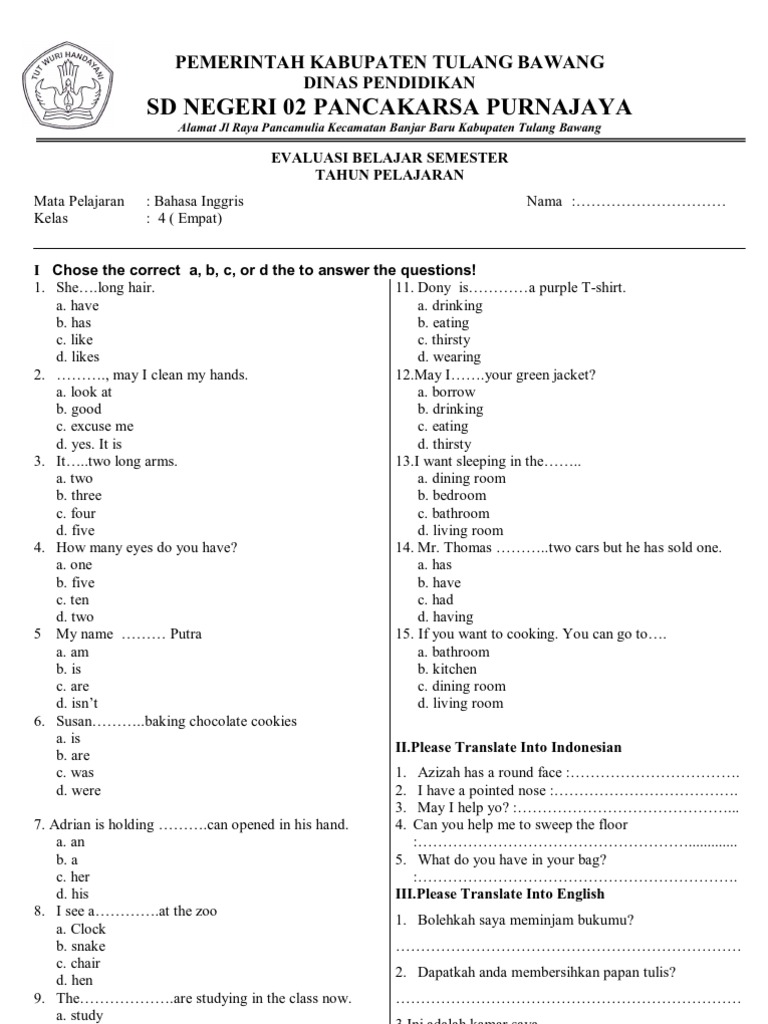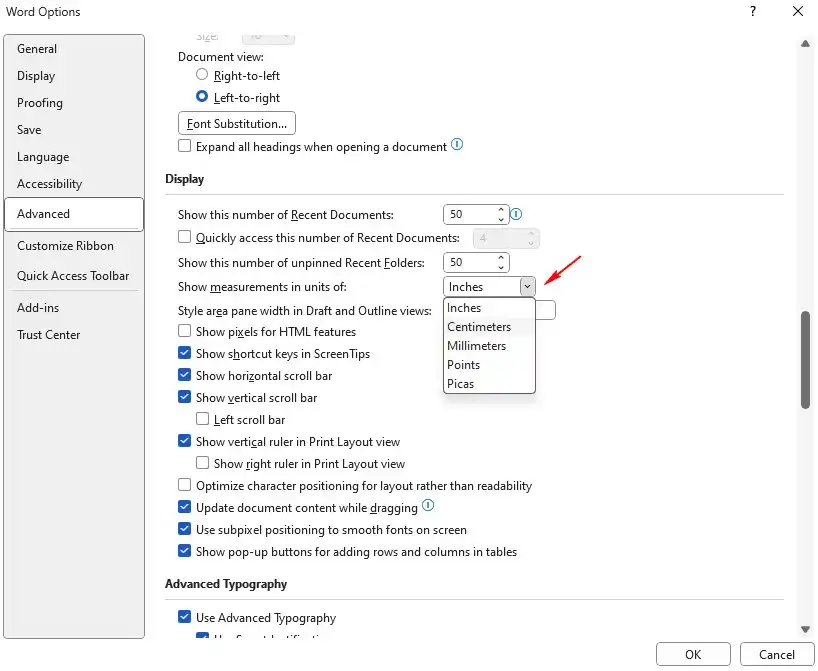A. Importance of English for Grade 4 Students
B. Scope of the Semester 2 Curriculum
II. Vocabulary and Spelling
A. Example Questions: Matching, Fill in the Blanks, Sentence Completion
B. Explanation and Answer Key
III. Grammar
A. Simple Present Tense: Affirmative, Negative, Interrogative
- Example Questions: Sentence Construction, Correcting Errors
- Explanation and Answer Key
B. Simple Past Tense: Regular and Irregular Verbs - Example Questions: Sentence Completion, Verb Conjugation
- Explanation and Answer Key
C. Plural Nouns: Regular and Irregular - Example Questions: Identifying Plural Forms, Forming Plurals
- Explanation and Answer Key
IV. Reading Comprehension
A. Short Story with Comprehension Questions
B. Explanation and Answer Key
V. Writing
A. Sentence Writing Based on Pictures
B. Paragraph Writing: Describing a Person or Place
C. Explanation and Answer Key
VI. Conclusion
A. Recap of Topics Covered
B. Importance of Continuous Practice
English Exercises for Grade 4 Semester 2
I. Introduction
Learning English is crucial for Grade 4 students. It lays a strong foundation for future language acquisition and enhances their overall communication skills. This article presents a comprehensive range of example questions covering key areas of the typical Grade 4 English curriculum during the second semester. These exercises focus on vocabulary, grammar, reading comprehension, and writing skills.
II. Vocabulary and Spelling
This section focuses on building a strong vocabulary and improving spelling accuracy.
A. Example Questions:
-
Matching: Match the words in Column A with their meanings in Column B.
Column A Column B 1. Happy a. Very big 2. Sad b. Feeling joyful 3. Huge c. Feeling unhappy 4. Small d. Very little -
Fill in the Blanks: Fill in the blanks with the correct words from the box. (box contains words: cat, dog, bird, sun)
The shines brightly. The barks loudly. The meows softly. The sings sweetly.
-
Sentence Completion: Complete the following sentences using appropriate vocabulary words.
a. The flower has a beautiful __. (color)
b. The boy is very __. (adjective describing a positive personality trait)
c. The weather is __ today. (adjective describing the weather)
B. Explanation and Answer Key:
- Matching: 1-b, 2-c, 3-a, 4-d
- Fill in the Blanks: The sun shines brightly. The dog barks loudly. The cat meows softly. The bird sings sweetly.
- Sentence Completion: Answers will vary depending on the student’s vocabulary. Encourage diverse and appropriate vocabulary usage. For example: a) color (red, yellow, blue, etc.), b) kind, helpful, friendly, etc., c) sunny, rainy, cloudy, windy, etc.
III. Grammar
This section emphasizes the understanding and application of fundamental grammatical concepts.
A. Simple Present Tense:
The simple present tense is used to describe habits, routines, and general truths.
-
Example Questions:
a. Sentence Construction: Write sentences using the simple present tense.
1. She (play) the piano every day. 2. They (not/like) spicy food. 3. Does he (go) to school by bus?b. Correcting Errors: Correct the following sentences.
1. He goes to the park everyday. 2. She don't like swimming. 3. Do they plays football? -
Explanation and Answer Key:
a. 1. She plays the piano every day. 2. They do not like spicy food. 3. Does he go to school by bus?
b. 1. He goes to the park every day. (Correct the spelling of "everyday") 2. She doesn’t like swimming. (Correct the contraction and verb form) 3. Do they play football? (Correct the verb form)
B. Simple Past Tense:
The simple past tense is used to describe actions completed in the past.
-
Example Questions:
a. Sentence Completion: Complete the sentences using the simple past tense of the verbs in parentheses.
1. I ____ (go) to the zoo yesterday. 2. We ____ (eat) pizza for dinner. 3. She ____ (read) a book before bed.b. Verb Conjugation: Conjugate the following verbs in the simple past tense: play, eat, walk, jump, sing.
-
Explanation and Answer Key:
a. 1. I went to the zoo yesterday. 2. We ate pizza for dinner. 3. She read a book before bed.
b. played, ate, walked, jumped, sang
C. Plural Nouns:
Plural nouns refer to more than one item.
-
Example Questions:
a. Identifying Plural Forms: Identify the plural forms of the following nouns: cat, dog, book, child, tooth.
b. Forming Plurals: Form the plural of the following nouns: box, bus, wish, leaf, city. -
Explanation and Answer Key:
a. cats, dogs, books, children, teeth
b. boxes, buses, wishes, leaves, cities
IV. Reading Comprehension
This section assesses reading comprehension skills using a short story.
A. Short Story:
(Insert a short, age-appropriate story here, approximately 100-150 words. The story should be simple and engaging, with a clear narrative.)
Example: Once upon a time, there was a little rabbit named Rosie. Rosie loved carrots more than anything in the world. One sunny afternoon, Rosie hopped into her garden to pick some fresh carrots. She found a huge, juicy carrot, the biggest she had ever seen! Rosie was so happy; she shared it with her friends.
B. Comprehension Questions:
- What was the rabbit’s name?
- What did Rosie love more than anything?
- Where did Rosie find the carrot?
- Describe the carrot Rosie found.
- What did Rosie do with the big carrot?
C. Explanation and Answer Key:
- Rosie
- Carrots
- In her garden
- Huge and juicy
- She shared it with her friends
V. Writing
This section evaluates writing skills through sentence and paragraph construction.
A. Sentence Writing Based on Pictures:
(Insert 3-4 simple pictures. Students will write a sentence describing each picture.)
B. Paragraph Writing:
Write a short paragraph (4-5 sentences) describing your favorite place.
C. Explanation and Answer Key:
Answers will vary depending on the student’s creativity and writing skills. Focus on evaluating sentence structure, grammar, spelling, and vocabulary usage. Provide constructive feedback to improve their writing.
VI. Conclusion
This article provided a range of example questions for Grade 4 English, encompassing vocabulary, grammar, reading comprehension, and writing skills. Consistent practice and engaging learning activities are crucial for building a strong foundation in English. Remember to provide positive reinforcement and encourage students to actively participate in learning. Continued practice and a positive learning environment will help students master these essential skills and build confidence in their English abilities.




